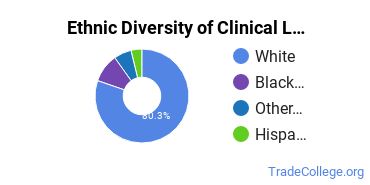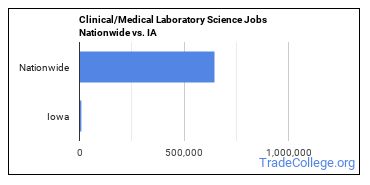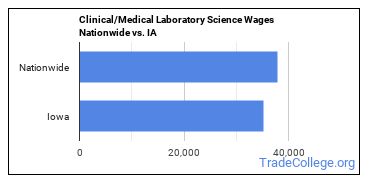Clinical/Medical Laboratory Science Schools in Iowa
In 2021-2022, 134 students earned their Clinical Laboratory Science degrees in IA.
As a degree choice, Clinical/Medical Laboratory Science is the 14th most popular major in the state.
Featured schools near , edit
Education Levels of Clinical/Medical Laboratory Science Majors in Iowa
Clinical Laboratory Science majors in the state tend to have the following degree levels:
| Education Level | Number of Grads |
|---|---|
| Award Taking Less Than 1 Year | 49 |
| Associate Degree | 48 |
| Bachelor’s Degree | 20 |
| Award Taking 1 to 2 Years | 17 |
| Award Taking 2 to 4 Years | 17 |
Gender Distribution
In Iowa, a clinical laboratory science major is more popular with women than with men.

Racial Distribution
The racial distribution of clinical laboratory science majors in Iowa is as follows:
- Asian: 10.4%
- Black or African American: 3.7%
- Hispanic or Latino: 8.2%
- White: 67.2%
- Non-Resident Alien: 0.7%
- Other Races: 9.7%

Jobs for Clinical/Medical Laboratory Science Grads in Iowa
6,570 people in the state and 643,760 in the nation are employed in jobs related to clinical laboratory science.

Wages for Clinical/Medical Laboratory Science Jobs in Iowa
In this state, clinical laboratory science grads earn an average of $35,150. Nationwide, they make an average of $37,990.

Most Popular Clinical/Medical Laboratory Science Programs in IA
There are 14 colleges in Iowa that offer clinical laboratory science degrees. Learn about the most popular 14 below:
Of all the students who attend this school, 69% get financial aid. Students who attend this public school pay an average net price of $10,465. In their early career, DMACC grads earn an average salary of $34,819.
Grads earn an average early-career salary of $60,277 after earning their degree at this institution. 47% of the teachers are full time. 9 to 1 is the student to faculty ratio.
This private institution charges an average net price of $21,599. The student loan default rate of 1.40% is a good sign that graduates can afford their loan payments. Students enjoy a student to faculty ratio of 5 to 1.
The student loan default rate is 2.20% which is lower than average. A typical student attending Hawkeye Community College will pay a net price of $11,000. Grads earn an average early-career salary of $36,020 after earning their degree at this institution.
Students enjoy a student to faculty ratio of 18 to 1. Roughly six years after entering college, graduates of this school earn $34,078 a year. This public college charges it's students an average net price of $9,422.
This private institution charges an average net price of $21,699. 9 to 1 is the student to faculty ratio. The student loan default rate is 0.90% which is lower than average.
Seeking financial aid? At this school, 96% of students receive it. Of all the teachers who work at the school, 37% are considered full time. In their early career, IHCC grads earn an average salary of $34,973.
The student to faculty ratio is 17 to 1. The student loan default rate is 7.40% which is lower than average. 95% of students are awarded financial aid at this school.
87% of students are awarded financial aid at this school. Students who attend this public school pay an average net price of $19,443. This school boasts a lower than average student loan default rate of 1.20%.
Graduates earn an average $45,044 after graduation. This school boasts a lower than average student loan default rate of 0.30%. 61% of the teachers are full time.
Of all the students who attend this school, 100% get financial aid. Students enjoy a student to faculty ratio of 13 to 1. The average student takes 4.10 years to complete their degree at Morningside.
It takes the average student 4.22 years to graduate. The student loan default rate of 1.40% is a good sign that graduates can afford their loan payments. In their early career, Mount Mercy grads earn an average salary of $48,677.
Students enjoy a student to faculty ratio of 12 to 1. This private school has an average net price of $23,185. Grads earn an average early-career salary of $43,201 after earning their degree at this institution.
The full-time teacher rate is 100%. It takes the average student 4.07 years to graduate. The student to faculty ratio is 14 to 1.
Clinical/Medical Laboratory Science Careers in IA
Some of the careers clinical laboratory science majors go into include:
| Job Title | IA Job Growth | IA Median Salary |
|---|---|---|
| Phlebotomists | 28% | $29,880 |
| Health Technologists and Technicians | 14% | $40,190 |
| Medical and Clinical Laboratory Technologists | 10% | $0 |
| Surgical Technologists | 10% | $40,200 |
| Medical and Clinical Laboratory Technicians | 10% | $0 |
| Medical Equipment Preparers | 8% | $34,290 |
| Ophthalmic Laboratory Technicians | 3% | $31,900 |
Related Majors in Iowa
Below are some popular majors in the state that are similar to clinical laboratory science.
| Major | Annual Graduates in IA |
|---|---|
| Nursing & Nursing Assistants | 1,762 |
| Allied Health Professions | 840 |
| Allied Health Services | 477 |
| Health/Medical Admin Services | 358 |
| Dental Support Services | 296 |
| Bodywork & Therapeutic Services | 102 |
| Health Sciences & Services | 54 |
| Mental & Social Health Services | 1 |
View all majors related to Clinical/Medical Laboratory Science
Explore Major by State
Alabama
Arkansas
Connecticut
Florida
Idaho
Iowa
Louisiana
Massachusetts
Mississippi
Nebraska
New Jersey
North Carolina
Oklahoma
Rhode Island
Tennessee
Vermont
West Virginia
View Nationwide Clinical/Medical Laboratory Science Report
References
- College Factual
- National Center for Education Statistics
- O*NET Online
- Image Credit: By Staff Sgt. Jerilyn Quintanilla under License
More about our data sources and methodologies.
Featured Schools
 Request Info
Request Info
|
Southern New Hampshire University You have goals. Southern New Hampshire University can help you get there. Whether you need a bachelor's degree to get into a career or want a master's degree to move up in your current career, SNHU has an online program for you. Find your degree from over 200 online programs. Learn More > |








